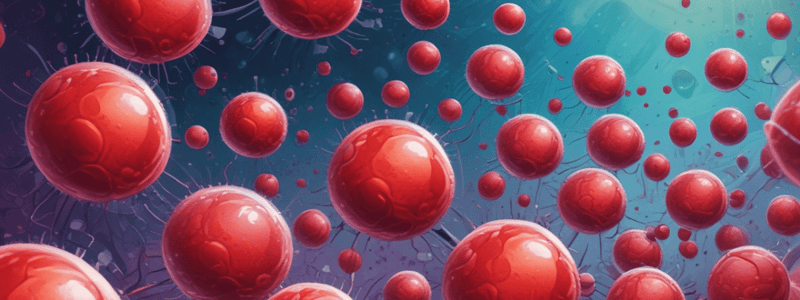Podcast
Questions and Answers
What is the location where all blood cells are produced?
What is the location where all blood cells are produced?
- Liver
- Blood vessels
- Kidneys
- Bone marrow (correct)
How many different kinds of blood cells are present in our blood at all times?
How many different kinds of blood cells are present in our blood at all times?
- 10 (correct)
- 12
- 8
- 5
What is the term used to describe the powerful stem cell in the bone marrow that can produce all 10 kinds of blood cells?
What is the term used to describe the powerful stem cell in the bone marrow that can produce all 10 kinds of blood cells?
- Hemopoietic
- Pluripotent (correct)
- Totipotent
- Multipotent
What is the main function of macrophages in our blood?
What is the main function of macrophages in our blood?
Why is it easy for cells to move from the bone marrow to the blood vessels?
Why is it easy for cells to move from the bone marrow to the blood vessels?
What are precursor cells?
What are precursor cells?
What is the significance of the bone marrow in our body?
What is the significance of the bone marrow in our body?
Why is the concept of pluripotency important in understanding blood cell production?
Why is the concept of pluripotency important in understanding blood cell production?
What can monocytes differentiate into besides dendritic cells?
What can monocytes differentiate into besides dendritic cells?
What is the primary function of macrophages and dendritic cells?
What is the primary function of macrophages and dendritic cells?
What is the key difference between monocytes and macrophages or dendritic cells?
What is the key difference between monocytes and macrophages or dendritic cells?
What happens to monocytes when they enter the tissues?
What happens to monocytes when they enter the tissues?
Which of the following is true about dendritic cells?
Which of the following is true about dendritic cells?
What is the primary location of monocytes?
What is the primary location of monocytes?
What is the process of producing blood cells called?
What is the process of producing blood cells called?
Which cell is more closely related to a red blood cell?
Which cell is more closely related to a red blood cell?
What does the megakaryocyte produce?
What does the megakaryocyte produce?
What is the main function of macrophages?
What is the main function of macrophages?
What two main lineages does the pluripotent hematopoietic stem cell give rise to?
What two main lineages does the pluripotent hematopoietic stem cell give rise to?
Which of the following cells is NOT produced by the myeloid lineage?
Which of the following cells is NOT produced by the myeloid lineage?
What is the function of mast cells?
What is the function of mast cells?
What type of cell does the monocyte become later on?
What type of cell does the monocyte become later on?
From which lineage do some dendritic cells originate?
From which lineage do some dendritic cells originate?
What is the function of the lymphoid progenitor cell?
What is the function of the lymphoid progenitor cell?
Flashcards are hidden until you start studying
Study Notes
Blood Cells and Their Production
- There are approximately 10 different kinds of blood cells in our body, including red blood cells, T-cells, B-cells, macrophages, and platelets.
Bone Marrow and Blood Cell Production
- All blood cells are produced in the bone marrow, which is inside the bones.
- The bone marrow is profuse with small blood vessels, making it easy for cells to move into the bloodstream.
Pluripotent Hematopoietic Stem Cell
- A pluripotent hematopoietic stem cell is a powerful cell in the bone marrow that can produce all 10 kinds of blood cells.
- This cell can divide into multiple cell types, giving rise to different lineages of blood cells.
Myeloid and Lymphoid Lineages
- The pluripotent hematopoietic stem cell gives rise to two main lineages: myeloid and lymphoid.
- The myeloid lineage produces red blood cells, megakaryocytes (which produce platelets), and certain immune cells like neutrophils, basophils, and eosinophils.
- The lymphoid lineage produces immune cells like NK cells, B cells, and T cells.
Macrophages and Red Blood Cells
- Macrophages are more closely related to red blood cells than to B cells or T cells, despite both being immune cells.
- Monocytes, which are similar to macrophages, come from the myeloid lineage and can also become macrophages or dendritic cells.
Dendritic Cells
- Dendritic cells can come from both the myeloid and lymphoid lineages.
- Those from the myeloid lineage are created from monocytes, while those from the lymphoid lineage come from a lymphoid precursor.
Monocytes
- Monocytes are circulating cells that move through the blood and can settle in tissues to become macrophages or dendritic cells.
- Unlike macrophages and dendritic cells, monocytes do not behave like sentinels watching for invaders in the tissues.
Studying That Suits You
Use AI to generate personalized quizzes and flashcards to suit your learning preferences.




